- Home
- Jack Kerouac
Book of Sketches
Book of Sketches Read online
Table of Contents
PENGUIN POETS
Title Page
Copyright Page
Dedication
Introduction
FIRST BOOK
PANORAMIC CATALOG SKETCH OF BIG EASONBURG
SECOND BOOK
PENGUIN POETS
PENGUIN POETS
BOOK OF SKETCHES
JACK KEROUAC was born in Lowell, Massachusetts, in 1922, the youngest of three children in a Franco-American family. He attended local Catholic and public schools and won a scholarship to Columbia University in New York City, where he met Allen Ginsberg and William S. Burroughs. His first novel, The Town and the City, appeared in 1950, but it was On the Road, first published in 1957, that made Kerouac one of the best-known writers of his time. Publication of his many other books followed, among them The Subterraneans, Big Sur, and The Dharma Bums. Kerouac’s books of poetry include Mexico City Blues, Scattered Poems, Pomes All Sizes, Heaven and Other Poems, Book of Blues, and Book of Haikus. Kerouac died in St. Petersburg, Florida, in 1969, at the age of forty-seven.
GEORGE CONDO is a painter and sculptor who has exhibited extensively in both the United States and Europe, with works in the collections of the Whitney Museum of American Art, The Museum of Modern Art, New York, and many other institutions. In 1999, Condo received an Academy Award from the American Academy of Arts and Letters and in 2005 he received the Francis J. Greenberger Award. He is represented by Luhring Augustine in New York, Andrea Caratsch Galley in Zurich, and Sprüth Magers Lee in London.
ALSO BY JACK KEROUAC
THE DULUOZ LEGEND
Visions of Gerard
Doctor Sax
Maggie Cassidy
Vanity of Duluoz
On the Road
Visions of Cody
The Subterraneans
Tristessa
Lonesome Traveller
Desolation Angels
The Dharma Bums
Book of Dreams
Big Sur
Satori in Paris
POETRY
Mexico City Blues
Scattered Poems
Pomes All Sizes
Heaven and Other Poems
Book of Blues
Book of Haikus
OTHER WORK
The Town and the City
The Scripture of Golden
Eternity
Some of the Dharma
Old Angel Midnight
Good Blonde & Others
Pull My Daisy
Trip Trap
Pic
The Portable Jack Kerouac
Selected Letters: 1940-1956
Selected Letters: 1957-1969
Atop an Underwood
Door Wide Open
Orpheus Emerged
Departed Angels
Windblown World
Beat Generation
PENGUIN BOOKS
Published by the Penguin Group
Penguin Group (USA) Inc., 375 Hudson Street, New York, New York 10014, U.S.A.
Penguin Group (Canada), 90 Eglinton Avenue East, Suite 700, Toronto, Ontario,
Canada M4P 2Y3
(a division of Pearson Penguin Canada Inc.)
Penguin Books Ltd, 80 Strand, London WC2R 0RL, England
Penguin Ireland, 25 St Stephen’s Green, Dublin 2, Ireland (a division of Penguin Books Ltd)
Penguin Group (Australia), 250 Camberwell Road, Camberwell, Victoria 3124, Australia
(a division of Pearson Australia Group Pty Ltd)
Penguin Books India Pvt Ltd, 11 Community Centre, Panchsheel Park,
New Delhi — 110 017, India
Penguin Group (NZ), cnr Airborne and Rosedale Roads, Albany, Auckland 1310,
New Zealand (a division of Pearson New Zealand Ltd)
Penguin Books (South Africa) (Pty) Ltd, 24 Sturdee Avenue, Rosebank,
Johannesburg 2196, South Africa
Penguin Books Ltd, Registered Offices: 80 Strand, London WC2R 0RL, England
First published in Penguin Books 2006
Copyright © John Sampas, Literary Representative,
the Estate of Stella Sampas Kerouac, 2006
Introduction copyright © George Condo, 2006
All rights reserved
LIBRARY OF CONGRESS CATALOGING-IN-PUBLICATION DATA
Kerouac, Jack, 1922-1969.
Book of sketches, 1952-53 / Jack Kerouac ; introduction by George Condo. p. cm.
eISBN : 978-0-142-00215-5
The scanning, uploading, and distribution of this book via the Internet or via any other means without the permission of the publisher is illegal and punishable by law. Please purchase only authorized electronic editions, and do not participate in or encourage electronic piracy of copyrighted materials. Your support of the author’s rights is appreciated.
http://us.penguingroup.com
Dedicated to the memory of
Caroline Kerouac Blake
INTRODUCTION
Thoughts about Jack Kerouac
Read this Book of Sketches and you’ll be amazed at what a genius Jack Kerouac was.
These poems just breathe and flow, and when Jack plays the Blues, which he often does, his blues are truly sad — they are sadness without humor, without the joking and backslapping that come from good times. They are the real unfunny truth. Like when his older brother Gerard died. This is one of the saddest poems ever written.
I learned a lot from Jack, and I can say all this not being a writer. At the age of fourteen he was the first radical I ever heard of. When I first became aware that he wrote his novel The Subterraneans in one long stretch, unrevised straight out of his head in three days, and that he had a “steel trap” memory — it was the combination of these two very important factors that inspired a new way of painting for me. From then on I combined memory, speed, and spontaneity to create most of my work. I relied on the Kerouacian notion of “the unrevised method of creation,” and it became the key to a pure uncontrollable mastery of chaos.
As a reader, you would think Kerouac was talking, not writing. Yet it was precisely everyday speech that he was able to conjure up. He, like Jackson Pollock, found a way to take something all of us see and use every day and turn it into Art. This new language of Jack Kerouac was the one we had always been speaking. You just had to know what you were talking about before you spoke.
Jack’s concept of writing was also very art-inspired — he drew on André Masson’s Automatic Painting and Charlie Parker’s informed improvisations to carve out his unique style and destination. He called upon Leonardo da Vinci’s method of observation in his studies of flowers, storms, anatomy, and physiognomy. Jack is to literature what Charlie Parker was to music or Jackson Pollock was to painting. It’s that simple. Proust should be invoked here, too. He must have been one of Kerouac’s favorite writers because he used him to describe Miles Davis’s phrasing in order to enhance a cultural value that had not yet been perceived — he spoke of Miles’s playing “eloquent phrases, just like Marcel Proust.”
To look at Edward Hopper’s paintings of the late 1920s and early 1930s is to see the destitute ambience of New York City and its existential paradox — it is a place at once industrious and at the same time empty, lonely, and unanswered. These qualities are found in some of Kerouac’s poetical sketches — gas stations, old barges, oil tankers, silhouettes of a positive industry set against dark empty exteriors that have been forgotten and misplaced: Indian land or an old gold mine, towns at one time prosperous now distinctly gone, reflecting an America that no one wanted to admit was still there.
Jack himself had a cubist take on Hopper — not unlike Joseph Stella’s faceted Brooklyn Bridge — cubist in the sense that the fragmentation is not of imagery but of time and spac
e. The elements of chronology in these sketches are here of no importance. In fact, Jack has made a note, “Not Necessarily Chronological,” this being on his mind — in a larger sense referring to all the poems in the Book of Sketches, but also referring to the sequence of words within each poem. That’s what gives a “sketch” its edge, the fractured, almost “cut-up” feel that the descriptions carry. They seem to be running straight at you and then split up unexpectedly into multiple directions simultaneously, ending on a resolved note somehow related and yet striking out in a new direction.
Unlike Hopper, though, Kerouac did not long for the past — he did not reminisce for the sake of nostalgia — or transpose the European masters’ sensibility. Rather, in the 1950s he broke free and prophetically dreamed a future world of young people wearing Levi’s and being cut loose from all the crumbling conventions. Jack saw into the future, he lived in the future. That is exactly what happened in the 1960s to society, but by then Jack was too old and self-abused to have any pleasure from the world he predicted.
As the sketches tell us, anything that Jack saw was important. Anything that caught his eye and that he wrote about became priceless. Because in the way that an artist like Picasso could see with his brush, Jack could see with his pen. He was able to capture the spirit of his time without making anything up. And as it came to us from nowhere it certainly was astounding how concrete it all is now. It is as if the only true picture of humanity we will ever have was given to us by Jack Kerouac. All else is false and dressed up. Only Jack and Vincent van Gogh told the inner truth.
— George Condo, November 2005
BOOK OF SKETCHES
JACK KEROUAC
Printed Exactly As They Were Written On the Little Pages in the Notebooks I Carried in My Breast Pocket 1952 Summer to 1954 December............
(Not Necessarily Chronological)
FIRST BOOK
Rocky Mt Aug. 7 ’52
Changed now to
dungaree shorts, gaudy
green sandals, blue vest
with white borders & a
little festive lovergirl ribbon
in her hair Carolyn prepares
the supper —
“I better go over there &
fix that lawnmower,” says
Paul standing in the kitchen
with LP at his thigh.
“Supper’ll be ready at
six.”
Glancing at his watch
Paul goes off - to his landlord
Jack up the road — a man his
age, of inherited wealth,
who spends all day in big
Easonburg walking around
or sitting in his vast brick
house (Jacky Lee’s father)
or walking down the road
to see his 2 new cows —
On the kitchen floor is
a pan of dog meal mixed
with milk & water but the
bird dog Bob isnt hungry,
just let out of the pen
he lays greedily sopping
up happy in-house hours
under the d.r. table — a
big affectionate dopey
beauty with great bony
snakehead & big brown eyes
& heartshaped mottled
ears falling like the locks
of a pretty girl do fall —
in the Fall a gliding phantom
in the pale fields.
Carolyn takes a pile
of dishes from the cupboard
& silverware from the
drawer & carries them
into the diningroom. Out of
the ref. she takes ready
to bake biscuit doughs &
unwraps them from their
cellophane, stuffs waste paper
in the corner bag that
sits in a wastebasket
out of sight — She
prepares the aluminum
silex for coffee — never
puts an extra scoop for
the pot — makes weak
American housewife coffee
— but who’s to
notice, the Prez. of the
Waldorf Astoria? — She
slams a frying pan on a
burner — singing “I hadnt
anyone till you & with
my lonely heart demanding
it, f-a-i-t-h must
have a hand in it — ”
mistaking “fate” — Out
comes the bacon & the
yellow plastic
basket of eggs — What’s
she going to make? Under
the faucet she cleans
garden fresh tomatos
from Mrs Harris’ —
She’s boiling potatos in a
pot — they’ve been there a
half hour — Thru her
little kitchen cupboard
window, framed like a
picture, see the old
redroofed flu cure barn
of the X farm — weary
gray wood in the eternities
of time — rickety poles
around it — the tobacco,
already picked from
the bottom a foot up,
pale & fieldsy before the
solemn backdrop of
that forest bush —
One intervening sad English
cone haystack — The
little children of the
Carolina suppertimes see
this & think: “And does
the forest need to eat?
In the night that’s
coming does the forest
know? Why is that dish
cloth hanging there so
still — & like the
forest — has no name
I know of — gloop — ”
Carolyn Blake is making
bacon & eggs & boiled
potatos for supper because
lately the family’s been
eating up breakfast
foods — just cereal & toast —
“Hm what pretty bacon,”
she says out loud. On
the radio now’s the
Lone Ranger. Lingering
statics clip & clop
amongst its William
Tell Overtures — a
rooster foolish crows —
Hand on hip, feet
crossed, casually, a cig
burning out in the ashtray,
she picks the bacon over
with a long cook fork.
“Hum hum hum” she hums.
Paul, having fixed the Jack
lawn mower, is in the yard
finishing the part of the lawn
last overlooked. The
deep rich fat grass lies in
serried heaps along the
trail of his machine
with the ditch, the road,
& the white road sign
“Easonburg” & yellow
“Stop” sign beyond — &
signs on a post pointing in
all the directions — ←
Route 95 2 → US 64
↓ Rocky Mt 3 ↑Sandy
Cross 4 — Paul, hat off,
sleeves rolled, glumly &
absentmindedly pushes at
his work; the motor makes
a drowsy suppertime growl
like the sound of a motor-
boat on some mystic lake
— At the crossroads store
groups of farmers have
gathered & smoke & sit
now. Heavenly mystical
lights have meanwhile
appeared in the sky as
the great machinery
continues in the High.
Intense interest is being
shown in the lawncutter —
Jack himself has just driven
over (on his way to town)
& is parked on lawn�
�s edge
discussing it with a young
farmer in overalls & white &
green baseball cap who app.
w. to buy it — Little
Paul runs to hear them
talk — At the store
five people are watching
intently. Men are be-
mused by machines. Americans,
by new, efficient
machines; Jack had the
money to buy a deluxe
cutter — 2 Negros
& 2 white farmers stare
intently at Paul in his
lawn, from the store, as
he backs up the car
to get to the grass
underneath it — Not once
has he lookt up & acknowledged
his watchers — works on.
Jack has driven off proudly
— Still another man
joins the watchers — &
now even George steps
out to see — now that
Jack’s driven off to whom
he hasnt spoken in years —
his twin brother. In Southern
accents — “Thats whut
ah think!” — they
discuss that splendid
grasscutter — Cars come
& park, & go — Cars
hurry on the hiway to
home,
“Wait till after
supper,” says Carolyn to
LP, “we’re ready to
eat now — ” as
he complains
“Ah — nao!”
but the complaint’s not
serious & doesnt last
long — And the air
is fragrant from cut
grass. “Come eat!”
And suddenly not a
soul’s at the store as
for other & similar &
just as blank reasons,
they’ve gone to
the silence
the suppers of their own
mystery.
Why should a chair be far
from a book case!
P: “Well that confound
yard is mowed.”
C: “Fi-na-lee.”
P: “Eat some supper
boy.”
C: — “What is it 27
now? 28? It musta
gone up, I thought

 Tristessa
Tristessa On the Road
On the Road The Dharma Bums
The Dharma Bums Maggie Cassidy
Maggie Cassidy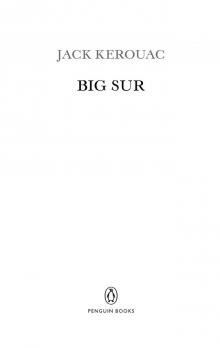 Big Sur
Big Sur Dr. Sax
Dr. Sax Vanity of Duluoz: An Adventurous Education, 1935-46
Vanity of Duluoz: An Adventurous Education, 1935-46 The Sea Is My Brother
The Sea Is My Brother The Town and the City: A Novel
The Town and the City: A Novel Atop an Underwood: Early Stories and Other Writings
Atop an Underwood: Early Stories and Other Writings Desolation Angels: A Novel
Desolation Angels: A Novel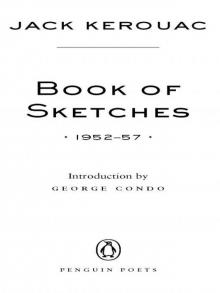 Book of Sketches
Book of Sketches Wake Up: A Life of the Buddha
Wake Up: A Life of the Buddha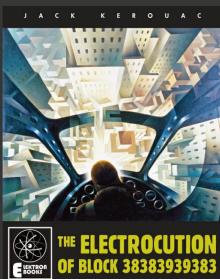 The Electrocution of Block 38383939383
The Electrocution of Block 38383939383 Haunted Life
Haunted Life Visions of Gerard
Visions of Gerard Orpheus Emerged
Orpheus Emerged Book of Blues
Book of Blues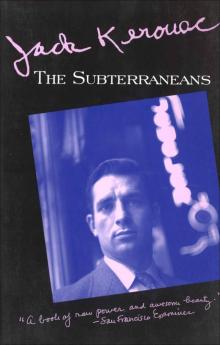 The Subterraneans
The Subterraneans The Haunted Life
The Haunted Life The Unknown Kerouac
The Unknown Kerouac The Town and the City
The Town and the City Visions of Cody
Visions of Cody Atop an Underwood
Atop an Underwood Lonesome Traveler
Lonesome Traveler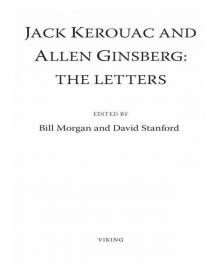 Jack Kerouac and Allen Ginsberg
Jack Kerouac and Allen Ginsberg Vanity of Duluoz
Vanity of Duluoz Desolation Angels
Desolation Angels On the Road: The Original Scroll: (Penguin Classics Deluxe Edition)
On the Road: The Original Scroll: (Penguin Classics Deluxe Edition) The Sea Is My Brother: The Lost Novel
The Sea Is My Brother: The Lost Novel Wake Up
Wake Up The Poetry of Jack Kerouac
The Poetry of Jack Kerouac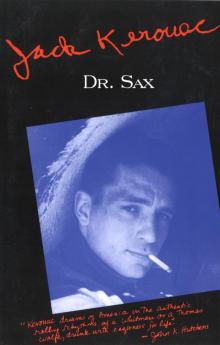 Doctor Sax
Doctor Sax